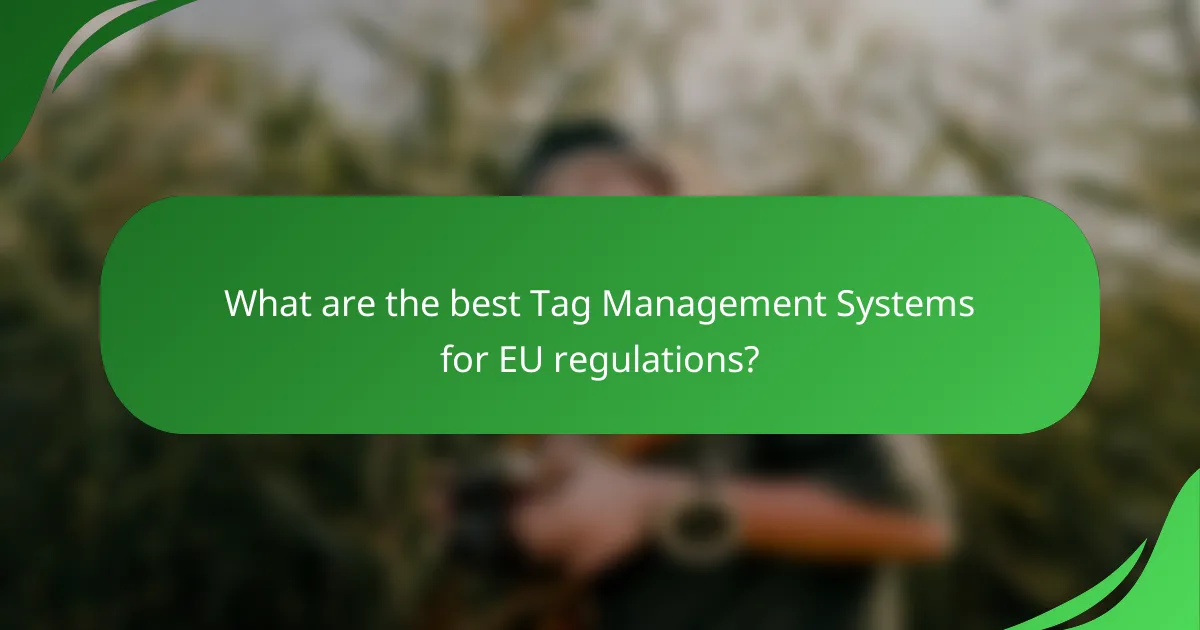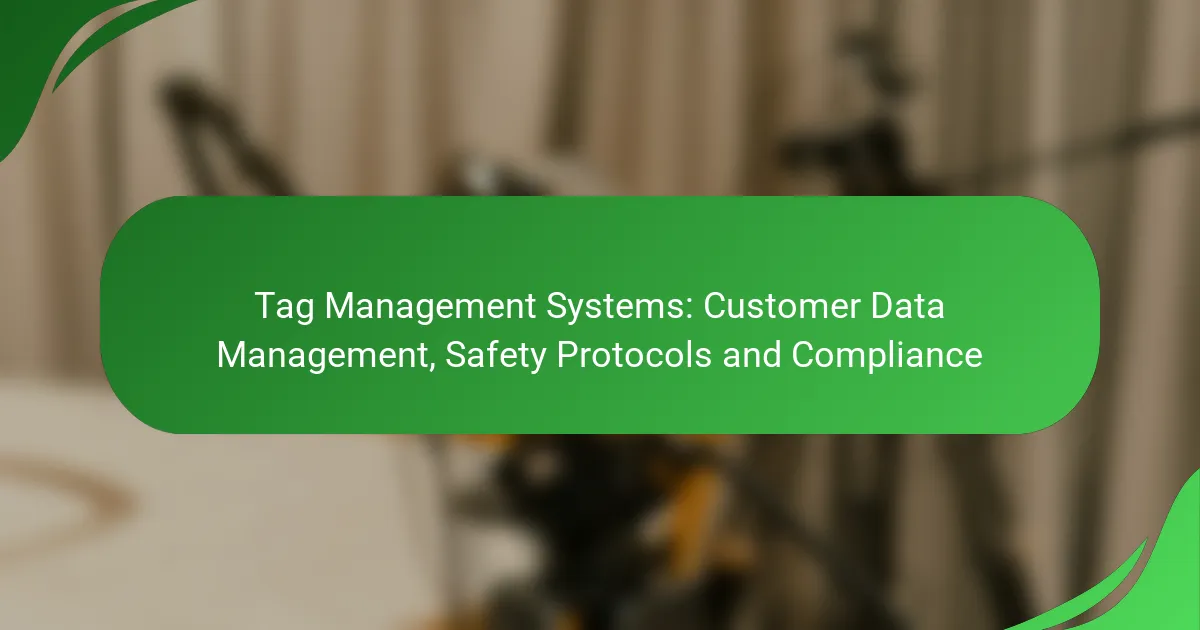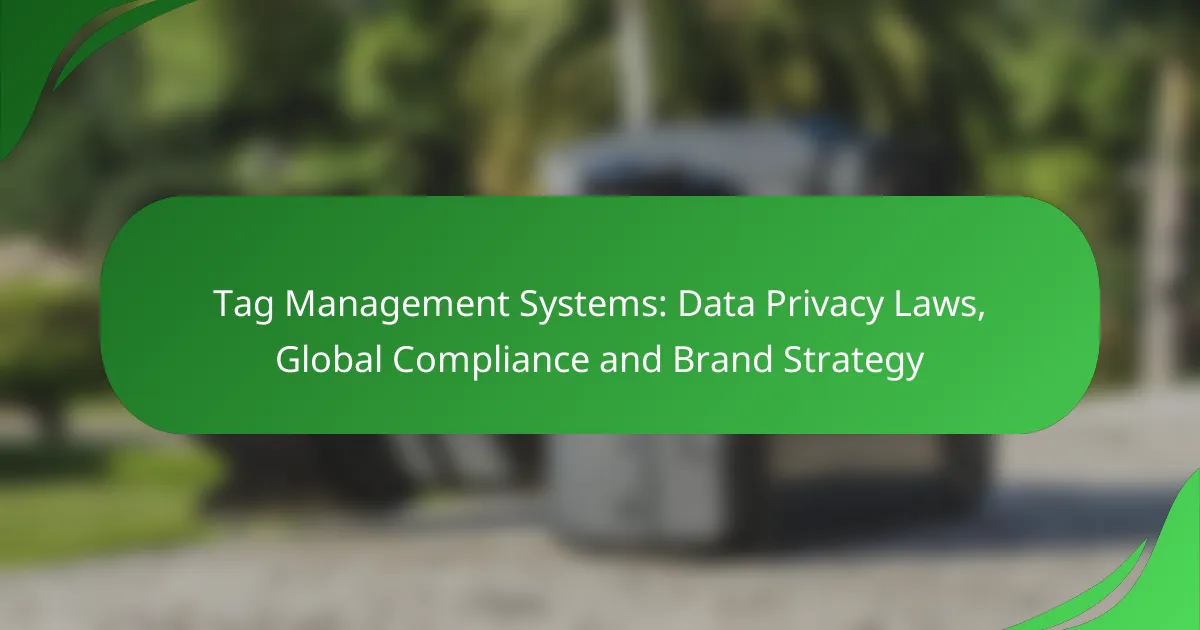Tag Management Systems (TMS) play a crucial role in helping organizations navigate GDPR compliance and adhere to EU regulations. By offering tools for managing user consent and ensuring data privacy, these systems enable businesses to streamline their data collection practices while maintaining legal compliance. Adapting TMS effectively involves implementing strong data management strategies and fostering transparency with users.

How do Tag Management Systems ensure GDPR compliance in Canada?
Tag Management Systems (TMS) help organizations in Canada comply with GDPR by providing tools for data privacy, user consent, and data handling practices. These systems streamline the management of tracking tags while ensuring that data collection aligns with legal requirements.
Data anonymization features
Data anonymization is a crucial feature in Tag Management Systems that helps protect user identities. By removing or altering personal identifiers from data sets, TMS can ensure that the information collected does not directly link back to individual users, thus reducing privacy risks.
For example, TMS can aggregate data or use techniques like pseudonymization, where identifiable information is replaced with artificial identifiers. This allows businesses to analyze user behavior without compromising personal data, which is essential for GDPR compliance.
User consent management tools
User consent management tools are integral to TMS, allowing businesses to obtain and manage user permissions for data collection. These tools enable organizations to present clear consent forms and track user preferences effectively, ensuring compliance with GDPR requirements.
For instance, a TMS can provide customizable consent banners that inform users about data usage and allow them to opt-in or opt-out. This transparency is vital for building trust and meeting legal obligations in Canada.
Privacy policy integration
Integrating privacy policies within Tag Management Systems is essential for maintaining compliance with GDPR. A well-defined privacy policy informs users about how their data is collected, used, and protected, aligning with legal standards.
Organizations should ensure that their TMS allows for easy updates to privacy policies and that these policies are readily accessible to users. Regularly reviewing and updating these documents helps maintain compliance and fosters user confidence in how their data is handled.

What are the best Tag Management Systems for EU regulations?
Several Tag Management Systems (TMS) are particularly suited for compliance with EU regulations, especially the General Data Protection Regulation (GDPR). Key systems like Google Tag Manager, Tealium, and Adobe Experience Platform Launch offer features that help businesses manage user consent and data privacy effectively.
Google Tag Manager
Google Tag Manager (GTM) is a widely used TMS that simplifies the process of managing JavaScript and HTML tags for tracking and analytics. It allows users to implement tags without extensive coding knowledge, which can be beneficial for GDPR compliance by enabling easy updates to consent management tools.
To ensure compliance, GTM supports custom triggers that can be set to fire only after obtaining user consent. This feature is crucial for businesses operating in the EU, as it helps prevent unauthorized data collection. Regularly reviewing and updating tags in GTM can help maintain compliance with evolving regulations.
Tealium
Tealium is a robust TMS that focuses on data governance and privacy, making it a strong choice for companies in the EU. It offers a comprehensive suite of tools for managing customer data and consent, which is essential for adhering to GDPR requirements.
One of Tealium’s key features is its Consent Manager, which allows businesses to capture and manage user consent preferences effectively. This system can be integrated with various marketing technologies, ensuring that only compliant tags are activated based on user consent. Regular audits of data practices using Tealium can help mitigate risks associated with non-compliance.
Adobe Experience Platform Launch
Adobe Experience Platform Launch is a powerful TMS that enables businesses to manage their marketing tags while ensuring compliance with EU regulations. It provides a user-friendly interface for deploying and managing tags, along with built-in privacy controls that align with GDPR standards.
This platform allows for the creation of rules that dictate when and how tags fire based on user consent. Additionally, Adobe’s integration capabilities with other Adobe products enhance data privacy management, making it easier to comply with local regulations. Companies should leverage these features to regularly assess their compliance status and adjust their tag strategies accordingly.

How can businesses adapt their Tag Management Systems for GDPR?
Businesses can adapt their Tag Management Systems (TMS) for GDPR compliance by implementing robust data management practices, ensuring user consent, and regularly reviewing their processes. This involves understanding the regulations, adjusting data collection methods, and maintaining transparency with users.
Implementing data retention policies
Establishing clear data retention policies is essential for GDPR compliance. Businesses should define how long they will keep user data and under what circumstances it will be deleted. A common practice is to retain data only as long as necessary for the intended purpose, typically ranging from a few months to a couple of years.
To implement effective retention policies, consider creating a data lifecycle management plan. This plan should outline data collection, storage, usage, and deletion processes. Regularly review and update these policies to align with changing regulations and business needs.
Regular compliance audits
Conducting regular compliance audits helps ensure that your Tag Management System adheres to GDPR requirements. These audits should assess data handling practices, user consent mechanisms, and overall compliance with data protection regulations. Aim to perform these audits at least annually or whenever significant changes occur in your data processing activities.
During an audit, evaluate whether user consent is properly documented and whether data is being processed according to the stated purposes. Identify any gaps in compliance and take corrective actions promptly to mitigate risks.
Training staff on GDPR requirements
Training staff on GDPR requirements is crucial for maintaining compliance within your organization. Employees should understand the principles of data protection, the importance of user consent, and the specific procedures your business has implemented to comply with GDPR.
Consider providing regular training sessions and resources, such as workshops or online courses, to keep staff informed about updates in regulations and best practices. Encourage a culture of data protection awareness, where employees feel responsible for safeguarding user information.

What are the key features to look for in a Tag Management System?
When selecting a Tag Management System (TMS), focus on features that enhance integration, data tracking, and user management. A robust TMS should streamline the implementation of tags while ensuring compliance with regulations like GDPR.
Integration capabilities
Integration capabilities are crucial for a Tag Management System, as they determine how well the TMS can connect with other marketing tools and platforms. Look for systems that support a wide range of integrations, including analytics, CRM, and advertising platforms, to ensure seamless data flow.
Consider whether the TMS offers pre-built connectors or APIs for custom integrations. A system with extensive integration options can save time and reduce the complexity of managing multiple tools.
Real-time data tracking
Real-time data tracking allows businesses to monitor user interactions as they happen, providing immediate insights into campaign performance. A TMS with robust real-time capabilities can help you make timely adjustments to marketing strategies based on user behavior.
Evaluate the speed and accuracy of data collection, as well as the ability to visualize this data through dashboards. Effective real-time tracking can significantly enhance decision-making and improve overall marketing effectiveness.
Customizable user permissions
Customizable user permissions are essential for managing access to a Tag Management System, especially in larger organizations. This feature allows administrators to define roles and permissions, ensuring that only authorized personnel can modify tags or access sensitive data.
When assessing a TMS, check for flexibility in permission settings, such as role-based access control. This can help prevent errors and maintain compliance with data protection regulations, especially in the context of GDPR.

What are the challenges of Tag Management Systems under GDPR?
Tag Management Systems (TMS) face significant challenges under the General Data Protection Regulation (GDPR) due to strict data privacy requirements. Organizations must ensure that their TMS complies with regulations regarding user consent, data security, and integration with existing systems.
Data breach risks
Data breaches pose a major risk for Tag Management Systems, as they often handle sensitive user information. If a breach occurs, organizations can face hefty fines under GDPR, which can reach up to 4% of annual global turnover or €20 million, whichever is higher.
To mitigate these risks, companies should implement strong encryption methods and regularly audit their TMS for vulnerabilities. Additionally, maintaining up-to-date software and security protocols is essential to protect against unauthorized access.
Complexity of user consent
Obtaining and managing user consent is a complex challenge for Tag Management Systems under GDPR. Organizations must ensure that they collect explicit consent from users before processing their data, which can complicate the tagging process.
Implementing a consent management platform can help streamline this process by providing clear options for users and tracking their preferences. It is crucial to keep consent records updated and easily accessible to demonstrate compliance during audits.
Integration with legacy systems
Integrating Tag Management Systems with legacy systems can be difficult, especially when those systems were not designed with GDPR compliance in mind. This can lead to inconsistencies in data handling and increased risk of non-compliance.
To address this, organizations should assess their existing systems and identify potential gaps in compliance. Gradually updating or replacing outdated systems can help ensure that all components work together effectively while adhering to GDPR requirements.



